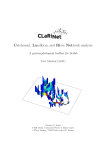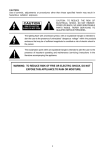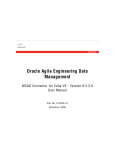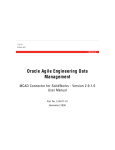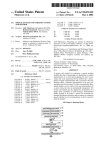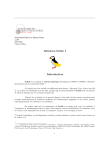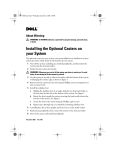Download Technical Publications - Single
Transcript
P T C . c o m White Paper Technical Publications Page 1 of 16 Technical Publications Improving the quality of technical publications increases employee productivity and customer satisfaction P T C . c o m White Paper Technical Publications Page 2 of 16 Introduction Ninety-percent of published information is stale; customers are overloaded with information, but usually cannot find what they need (e.g. lengthy user manuals describing a multitude of options not included in the customer product; responses to RFPs that do not include current configurations, etc.); the field force is dispatched to service calls with incorrect instructions; help desks desperately shuffle through a myriad of papers to find obsolete answers; manufacturers frequently publish incomplete or outdated information. It’s no wonder that customer satisfaction is low, service costs are growing, and legal exposure is high. Creating and using redundant, inconsistent, and unstructured information for formal publishing requirements is a recipe for failure. Just as you wouldn’t tolerate uncontrolled data in your organization’s financial management systems, you can no longer afford to handle your intellectual content in an uncontrolled, unconstrained, error-prone, and highly labor-intensive manner. By using traditional publishing software, authors typically waste 30% to 50% of their time formatting documents instead of focusing solely on content creation and improvement. Often, authors must recreate content that already exists because that content can’t be located or easily referenced for re-creation. Inconsistencies in the sequence and structure of information across similar documents make the information difficult for readers to understand. Lastly, lack of an automated publishing process forces authors to manually update multiple documents whenever a product or service changes, which is a time-consuming and error-prone process. By optimizing your technical publications process to enable concurrent development of engineering designs, your company can gain a significant competitive advantage and achieve lasting differentiation from your competition. Just think: • What if you could speed time-to-market by developing documentation concurrently with product designs, ensuring that when product development is complete, a product is ready to ship with documentation available in multiple languages and multiple media formats? • What if you could eliminate 30% of your service costs by maximizing the effectiveness of your service calls? What if you could supply your service professionals with real-time, customized instructions with embedded interactive illustrations and step-bystep instructions for the required service procedure? • What if you could deliver the most current, personalized training materials automatically to all your training locations, while eliminating 75% of your publication costs? • What if you could guarantee the accuracy of all your publications by ensuring that key text components and product illustrations automatically update when product designs change? • What if you could maximize your ability to win new business by cutting proposal response time by 50%? • What if you could automatically deliver personalized documentation to all your customers, while quadrupling the frequency of documentation updates? • What if you could eliminate the need to create 1/3 of all new documents by making it easy to reuse existing information? • What if you could eliminate up to 80% of your translation costs by ensuring that only new content gets translated? The following paper will discuss how you can improve the quality of your publications, and why a product development system that incorporates publishing in your product development processes is essential to solving your information quality problems. P T C . c o m White Paper Technical Publications Page 3 of 16 Contents Current Challenges with Technical Publications . . . . . . . . . . . . . . 4 Poor Information Quality Impacts Organizational Performance and Corporate Profitability . . . . . . . . . . . . . . . . . . 4 Traditional Technical Publishing Systems Limit the Benefits of ECM . . . . . . . . . . . . . . . . . . . . . . . . . . . . . . . . . . . . 4 When Should an Organization Consider Adopting an Automated Approach to Publishing? . . . . . . . . . . . . . . . . . . . . . 6 Best-Practice Approach to Creating and Managing Technical Publications . . . . . . . . . . . . . . . . . . . . . . . . . . . . . . . . 6 Creating Technical Publications . . . . . . . . . . . . . . . . . . . . . . . . 6 Collaboration Requirements . . . . . . . . . . . . . . . . . . . . . . . . . . . 9 Content Control and Management . . . . . . . . . . . . . . . . . . . . . .10 Configuration Management . . . . . . . . . . . . . . . . . . . . . . . . . . .11 Communicating Content – Publishing Technical Documents . . . . . . . . . . . . . . . . . . . . . . .12 Choosing the Right System Architecture – Critical Component for Automating Publication Processes . . . .14 PTC’S Product Development System: An Integral Solution For Technical Publications . . . . . . . . . . . . . . . . . . . . . .14 Flexible System Architecture . . . . . . . . . . . . . . . . . . . . . . . . . . .15 PTC Global Services Ensures Organizations Realize the Maximum Value from Their Dynamic Publishing Investment . . . . . . . . . . . . . . . . . . . . . . . . . . . . . . . . . . . . . . .15 Conclusion . . . . . . . . . . . . . . . . . . . . . . . . . . . . . . . . . . . . . . . . .16 P T C . c o m White Paper Technical Publications Page 4 of 16 Current Challenges with Technical Publications Traditional Technical Publishing Systems limit the Poor information quality impacts organizational Manufacturers with limited content management experience believe that deploying a content management system alone will solve their technical publications problems. Content management systems offer organizations the ability to impose controls over the process related to content creation and publishing. As a result, users can have a formal, predictable and secure way of assigning tasks for creating new information or updating existing information. However, traditional publishing systems, such as word-processing and desktop publishing software, waste organizations' time and resources while limiting the benefits that Enterprise Content Management (ECM) can deliver. This waste arises from the way that traditional word-processing and desktop publishing software lets authors create and publish information. benefits of ECM performance and corporate profitability The inability to reuse information and to automate publishing is one of the largest areas of inefficiency in today’s corporate environments. When totaled, these inefficiencies have a dramatic, but typically unrecognized impact on internal costs, revenue recognition, productivity, time-to-market, and customer satisfaction. In today’s competitive environment, customer demands for greater innovation must be met by bringing products to market in a timely fashion at the lowest possible cost. Technical publications are an integral part of the overall product or service introduction and span multiple corporate functions. Although senior management often overlooks the impact of technical documentation, an inefficient publishing process can have a significant effect on the financial success of a product or service. Technical publications (product or service manuals, installation guides, warranty information, sales and marketing materials, etc.) must always incorporate the most accurate product information. A common practice among companies that employ traditional publishing software is to postpone documentation development until the conclusion of the product or service development phase, when all design changes have supposedly been made. Often, this strategy leads to product launch delays, missed market opportunities, and revenue losses. Additionally, such last-minute publishing cycles place undue pressure on the publishing team, resulting in overtime and inaccurate product information. The net impact of this approach is, inevitably, a loss of customer satisfaction, higher service costs, and possible liability exposure. Technical Publications are important to many Product Development Processes The primary limitations of traditional word-processing and desktop publishing software include: • Manual updates. Copying/pasting content is a common method for making changes when using desktop publishing. Although this method may add to authoring efficiency when creating a standalone document, it greatly complicates the maintenance of documents. Changes to content require authors to manually search and update redundant content in multiple sections within multiple documents. Changes are the writer’s nightmare, and account for a major portion of authors’ “wasted effort”. Additionally, the process is error-prone and often causes inconsistencies or inaccuracies in published content. • Manual formatting. Authors typically spend between 30% and 50% of their time formatting documents in traditional publishing applications applying character, paragraph and page styles. Even when provided with authoring templates, most authors make formatting and style changes to each document as they write. If the document is a small, simple, one-off communication such as a memo or email, the wasted effort of manual design and formatting is usually not significant. However, for long documents composed from legacy information and subjected to repeated revision cycles, this manual effort compounds and leads to an excessive waste of manpower, resulting in inefficiency and production delays. • Recreating existing content. Authors will recreate content that already exists if they cannot find it. And when they do find the content, authors typically copy and paste it into the new document. Both approaches are wasteful because making subsequent improvements to the information requires finding, updating, and reviewing all documents containing the repeated passage, caption, or phrase. Where localized versions of the content are required, translation fees can add exponential cost to a publishing operation. Furthermore, rewriting content instead of reusing it not only increases the cost and time to develop the content, but also raises the risk that redundant information is inconsistent with other documents, making it even more difficult to update. P T C . c o m White Paper Technical Publications Page 5 of 16 • Lack of structure. Inconsistencies in the sequence and structure of information across similar documents make the content more difficult for readers to understand and more difficult for your authors to find and update. Unstructured information is impossible to re-use or automatically format. A computer program cannot process inconsistent input—the classic “garbage in, garbage out” problem. Lack of structure adds redundant cycles of review and edit to the publishing process, as multiple updates must be circulated. • Inefficient process for creating technical illustrations. Technical illustrations are core to technical publications. A typical company develops hundreds to millions of technical illustrations and maintains those illustrations for the life of the product. For most companies, the process of creating technical illustrations is riddled with inefficiencies. First, the vast majority of illustrations are redrawn from scratch or with reference to a 2D product image using general-purpose illustration systems. General-purpose illustration tools are excellent for drawingfree-form graphics, photo-editing and touch-up, and creating high-quality color images. However, these tools can't understand the technical aspects of manufactured products, and provide no means to speed and simplify common tasks performed by technical illustrators. A second major area of inefficiency is the process of transferring product data to technical illustrators. Illustrators often get information about their subject from engineers and designers who designed the product using 3D CAD and 2D engineering drawings. However, few companies take advantage of their rich CAD data. Illustrators rely on CAD users to open the CAD file, orient the product or assembly in a precise position, take a screen shot, and send the stored file to the illustrator. If the illustrator needs another view, the CAD user needs to repeat the process. It’s no wonder that CAD users view this process as low value-add and are not responsive to illustrators’ requests. And what happens if there’s a change to the product? Illustrators have to go back to the CAD user for updates, and then manually reapply their own changes. And, since illustrators are not welcome by CAD users, it’s not a surprise that they are reluctant to go back for updates. This process is further complicated if the technical illustration process is outsourced, further delaying the availability of the finished publications. Coupled with the fact that illustrators often don’t find out about changes to the product that require updates to the illustration, it’s not uncommon that publications do not reflect the configuration of the product in the field, a situation that ultimately results in increased costs. So, if desktop publishing and word processing are so problematic, why are they so popular? For most organizations using these methods, traditional publishing software actually provides many benefits compared to the publishing tools it replaced. For example, desktop publishing provides a quick and easy way to make changes and preview the result before printing. However, while desktop publishing may be appropriate for some types of documents, many companies are unaware that there is an alternative that lets you publish better information more efficiently. Example: Typical technical publications process within a manufacturer 2 CAD (t,$) Change = Rework Change = Rework Technical Illustration (t,$) Word Processing (t,$) JPEG or redrawn JPEG Translation (t,$) PDF English PDF German Native CAD Native Illustration PDF Others MS Word Change = Rework Web Autho ring (t,$) Change = Rework Translation (t,$) HTML German HTML Japanese HTML Others HTML Change = Rework The technical documentation process typically begins within engineering, which, using mechanical and/or electrical CAD software, creates a design. That design, or more precisely, a rendition of that design, is passed to a technical illustrator. The illustrator adds line art, removes unnecessary details, and makes the graphic suitable for publication. A vast majority of illustrations are redrawn from scratch using general-purpose illustration systems that do not understand the technical aspects of manufactured products. This process is further complicated if the technical illustration process is outsourced. The graphic is then passed on to a writer, likely in a format such as CGM, JPEG or GIF. The writer, using a desktop publishing application, supplements text with graphics. This combined set of information is then translated into all desired languages, formatted for print or PDF, and published. Perhaps, in conjunction, a Web team copies and pastes the same source content and prepares it for presentation on the Web. These Web pages also undergo translation. While not very efficient, this process might still be viable were it not for the inevitable reality of information-change. Changes to original product content can wreak havoc to work in process documentation, requiring all downstream functions to redo massive amounts of work. Since making changes has proven so problematic, those involved in technical publications often wait until the last moment to begin the process, hoping that such a tactic will minimize the likelihood of change. However, this method, too, is undesirable because it places technical publications on the critical path of product development. Often, manufacturers find that they may have the physical product ready, but are unable to ship due to a lack of supporting documentation. This results in product delays, lost/delayed revenue, and dissatisfied customers. These issues are further complicated by the typically chaotic environment already in place. Disconnected silos of information, lack of data version control, inadequate security/information access, and inefficient means of internal/external communication, all serve to exacerbate the above problems. For example, the Change Management Process for the engineering or design group is often completely disconnected from the technical publications group. As a result, changes in design are not communicated formally, consistently, and automatically. P T C . c o m White Paper Technical Publications Page 6 of 16 When should an organization consider adopting an automated approach to publishing? You should consider evaluating the benefits of replacing traditional desktop publishing or word processing software if your content has one or more of the following characteristics: • Multi-channel Delivery – When you have to deliver content in print, on the Web, in online help, to wireless devices, or to additional formats and media types, traditional publishing software requires you to assign someone to manually format your content for each different media type. Not only does this manual effort waste time and money, it also leads to inconsistencies in the resulting content, which can lead to customer dissatisfaction or legal liability. • Multiple Embedded Diagrams — The inability to embed interactive illustrations which automatically update when content changes, forces authors to write excessive verbal descriptions and incorporate inaccurate, out-of-date graphics. • Large Volume – The more content you create, the more costly it becomes to use traditional publishing software, because authors typically spend as much as half their time formatting documents— a waste of time and money. • Repeatable Processes – The more frequently you create and publish documents of a particular type, such as datasheets, technical manuals, proposal responses, or service instructions, the more consistent the documents should be in style and structure. Desktop publishing software works against this goal by giving the user complete freedom to change each document’s style and structure. The resulting inconsistencies not only reduce readability and utility for consumers of the information, but also make downstream automation such as automatic publishing to multiple types of media impossible. • Personalized Content – Consumers of information increasingly expect content to be tailored to meet their needs. They want only content that is relevant to their use case. Using desktop publishing software to produce tailored publications is rarely efficient on any scale. • Configurable Products – If you manufacture highly configurable products with multiple user options, desktop publishing software forces you to either publish long documents with a lot of irrelevant information, or to spend excessive time creating individual publications for each product configuration. • Dynamic Content – If portions of the content change frequently, such as prices, dates, seasonal provisions, or configuration requirements, traditional publishing software is, by far, the least efficient means to process the change. • Interactive Content – The Web and, to varying degrees, other electronic delivery media are great at providing an interactive experience to the consumer. Features such as advanced navigation aids, hotspots, hyperlinks and dynamically showing or hiding content engage the consumer and provide a faster, more satisfying experience. The manual steps required for adding these features, when converting word-processed or desktop published documents to a Web-friendly format, can be daunting. Often, the labor costs for such conversions force companies to compromise their Web applications with static text and minimal linking. Billions in Savings with Dynamic Publishing Aerospace Reduced publishing time from 12 weeks to 12 minutes. Automotive Reduced production time for automotive service documentation from 3-10 months to 3 weeks. Manufacturing Reduced manufacturing time by 50% by removing the bottleneck due to documentation. Medical Equipment Reduced translation costs by 65%, from $41/page to $14/page. Best-Practice Approach to Creating and Managing Technical Publications An effective technical publishing system must allow for concurrent development of the product and accompanying illustrated publications across a distributed environment. The system must address all phases of content development: content creation, collaboration and review with subject matter experts; control and management of content; configuration management; and automatic communication by distributing content to multiple targets and publishing to multiple media. These capabilities must be built on an architecture that maximizes the system’s usability and reliability, and minimizes deployment costs. Creating Technical Publications The key to successful automation of the publication process is componentization. By splitting up your documents into reusable components that are big enough to be worth managing separately, yet small enough to reuse in multiple instances, you can create a single source of information, so that making just one change can update multiple documents at once. A single source also leads to the reduction or elimination of redundancy, which enables you not only to reduce translation costs to only those information components that have changed, but also to ensure the integrity and accuracy of your information. Componentization is also critical for personalization. Creating information in smaller components allows you to set up a system to assemble and reuse those components dynamically to suit the needs of various audiences. To make componentization work, the components must be interchangeable, and they must fit correctly into the publications that contain them. For example, you may choose to create two different sizes of components such as ‘warnings’ and ‘topics’, where warnings fit into topics and topics fit into books. P T C . c o m White Paper Technical Publications Page 7 of 16 Another key to successful automation is an absolutely consistent structure and data format. While the formatting of an individual business document suggests a structure that’s obvious to anyone looking at it, authors freely alter structure and formatting to suit their circumstances and tastes. The result is that documents of the same type will have similar but not identical formatting, and similar but not identical structures. These inconsistencies, however small, make automation impossible. Bear in mind that the publishing process cannot be fully automated without the ability to automatically create technical illustrations. The publishing system must provide capabilities to create illustrations that would leverage accurate product design data, to automatically create high-quality illustrations by removing insignificant details and emphasizing key details, and to maintain the accuracy of publications by automatically updating all illustrations when product designs or configurations change. Another key to automation is separating the information from its style or presentation. In office automation, that means storing data in databases and extracting it for various purposes. Accountants can produce tabular reports, charts, and graphs in virtually endless combinations, even though the data in its raw form would be unintelligible to them. Applying this principle to technical publications means that you can use the same information in different types of documents with different formatting, without manually modifying the information itself. Essentials of Automated Publishing System: XML enables several critical requirements for automating the publishing process. Componentization – enables reuse, single-sourcing and personalization Through XML, one can specify the size of the reusable information components in a consistent way, enabling easy interchange of one component for another. PTC’s support for DITA, an application of XML that’s particularly well-suited to publishing, brings state-of-the-art support to developing and publishing of componentized, reusable information. Structure and Consistency – essential for automation XML makes structure explicit and ensures absolute consistency of your documents. In that respect, XML is unique. No other standard data format (except SGML, the predecessor to XML) can represent all types of information – text, data and graphics. A DITA-enabled publishing system allows authors to produce high-quality information by enforcing consistent implementation. Single Source – eliminate the ongoing time and expense of maintaining redundant information, while ensuring its integrity By enforcing consistent structure of all document components, XML facilitates identification and consolidation of redundant content, and reuse and re-purposing of information components. Separation of Content from Formatting – required to deliver the same information in multiple documents and file formats with multiple styles XML also enables the separation of content from its presentation. XML represents information in a “media neutral” form that is not constrained by the limitations and capabilities of any particular medium, so you can create information in its “pure” form, and separately process it to produce information products. Automation – assemble information for multiple audiences, and publish to multiple types of media, without human intervention One of the advantages of this separate process is that through automation, the information can be presented with absolutely consistent formatting regardless of the author, and it can take full advantage of the capabilities of each medium. Publishing systems that leverage the DITA data model enable organizations to adapt (i.e., specialize) their XML data models to better meet different needs, while preserving interoperability with similar specialized XML models and with all downstream applications that use a DITA-based data model. P T C . c o m White Paper Technical Publications Page 8 of 16 CREATE content with Arbortext and Pro/ENGINEER® For over 20 years, PTC has been instrumental in solving the challenges surrounding the development of complex content. Both Arbortext Editor and Pro/ENGINEER share the same concept of modular design and associativity of content. Furthermore, Abrortext IsoDraw leverages Pro/ENGINEER and other CAD content to create rich technical illustrations. Arbortext Editor Pro/ENGINEER Authors use Arbortext Editor to author business, technical, and reference documents. Arbortext enables you to: create and edit XML and SGML content; work with content both as components and as compound documents; reuse content across your organization; and improve the accura- PTC’s integrated 3D CAD/CAM/CAE solution, Pro/ENGINEER, allows cy, consistency and flexibility of your information. Arbortext looks and designers to model faster than ever, while maximizing innovation and works like familiar word processing software – yet provides all the power quality to, ultimately, create industry winning products. And, because and flexibility authors need. Arbortext lets authors attach audience Pro/ENGINEER applications are fully integrated, you can develop every- information to content for producing customized publications, and thing from the design concept to manufacturing tool paths within one embed data from databases, business systems, and other data sources. application, with the confidence of knowing every design change will Using Arbortext for document authoring enables a company to automate automatically be propagated to all downstream deliverables. the publications process and benefit from dynamic publishing. Arbortext IsoDraw Arbortext IsoDraw is the ideal tool for companies that need to incorporate product information in their technical publications. Arbortext IsoDraw enables illustrators to create high-quality technical illustrations in a quick and cost effective way. Illustrations can be created from scratch, photo-traced, or by reusing existing data (scans, CAD data etc). Arbortext IsoDraw automatically converts 3D design data into technical illustrations, thus offering an unprecedented productivity increase: CAD files that normally would take hours to edit are now available in a matter of minutes. Finished illustrations can be reused in all standard DTP/Publishing systems. In addition, Arbortext IsoDraw provides a wide range of functions for preparing illustrations for delivery on CD-ROM or via the Internet. By automatically embedding illustrations derived from Pro/ENGINEER into Arbortext-authored documents, companies can create rich publications that communicate information accurately and quickly. P T C . c o m White Paper Technical Publications Page 9 of 16 Collaboration Requirements The key to efficient technical publication development is to allow authors to work on different publication components simultaneously. By replacing linear redundant processes with concurrent processes, you can substantially reduce the overall publishing cycle and accelerate time-to-market. Technical publications typically have multiple contributors who are often geographically dispersed. Project collaboration tools are required to enable work-in-process collaboration with subject matter experts from both within and outside your organization. Efficient collaboration requires the flexibility to allow individual contributors to work independently to generate digital content and to periodically share that content with each other. At the same time, team members need a common view of the project plan and current status. Content management tools must detect important changes and automatically notify project members. Furthermore, these tools should protect content from unauthorized changes, maintain a history log of all document modifications, enforce interim checkpoints, and manage multiple review and approval cycles. Configuration management capabilities are necessary to ensure that authors are working with the right version of content; this results in higher productivity and quality. COLLABORATE with Windchill® Effective collaboration can improve the quality of your content, accelerate time-to-market, and reduce costs. PTC has been at the forefront of enabling companies to achieve their globalization initiatives by providing its customers with an open, heterogeneous, secure collaboration environment through Windchill. With Windchill, companies can securely harness the talents and energy of the entire team--inside or outside their firewall. Through its virtual workspace, Windchill provides access to information at the right time, keeping the team aligned, on track, and moving forward. This solution accelerates time–to-market by providing real-time visibility into current “Collaborative solutions can reduce the product development cycle by as much as 40%.” – Giga Information Group documents, parts, and plan information. Windchill manages content developed using PTC’s other solutions, including Pro/ENGINEER, Arbortext Editor, and Arbortext IsoDraw, enabling companies to optimize cross-enterprise activities for the purposes of developing product information and technical publications. This seamless operation provides a powerful collaboration environment, while maintaining visibility and traceability of the document creation process as required by corporate governance initiatives. “Collaborative development reduces data proliferation by 30%.” – McKinsey PTC’s visualization software – ProductView – enables viewing and verification of MCAD, ECAD, and documentation regardless of the source system. ProductView provides access to this information in a ‘lightweight’ format, and allows users to interrogate and mark-up viewables to share with others in the process. This capability facilitates collaboration during the process of developing technical publications. “Workforce inefficiencies related to publishing will cost organizations across the globe approximately $750 billion.” – A.T. Kearney P T C . c o m White Paper Technical Publications Page 10 of 16 Content Control and Management What would happen to your publications process if your core intellectual content were stored in many different locations and repositories, so that when individual components changed, you had to track down all of them before publishing a document? Can you imagine what would happen if the service manual for an airplane didn’t accurately reflect the current configuration of the plane? It would result in chaos, liability, and an unacceptable safety risk. Content control and management are necessary to optimize the technical publishing process. There are several key capabilities you should look for in your content management system: • Support for Structured XML Content – Support for XML within a content management system can vary from simply recognizing XML as a different file type to providing considerable XML-specific capability such as: checking XML documents to make sure they are valid; automatically bursting documents into reusable components; assembling components into whole documents; and automatically handling all related files that together make up an XML compound document1. • Lifecycle Management – Publications naturally go through various lifecycle states such as “Work-In-Progress,” “In Review,” “Released and Available,” and “Obsolete.” Managing content through lifecycle states enables companies to route information based on lifecycle states and to give access to the right people so they can perform lifecycle-specific tasks on that content. • Business Process Automation – The capability to graphically model a workflow-driven process, automatically trigger the start of the process based on specific circumstances, and monitor the progress of the running process – and intervene, if necessary – delivers great value to the publications process, particularly for complex processes. Sophisticated publishing applications require workflows to guide the steps of reviewing, approving, translating and publishing, and have the scalability and flexibility to be defined for specific document components or for collection of components. Workflow-driven process automation enables automatic management of heterogeneous documents consisting of multiple types of content. 1 DTD or Schema and a stylesheet are needed in order to use a typical XML document. • Dynamic Management of Multiple Types of Content – Technical publications incorporate multiple types of content such as text, interactive graphics and illustrations, links, multimedia objects, and MCAD and ECAD objects. In order to automate the publishing process, all content components must be managed dynamically within the content management system. When you make a change to one of your content components, you want all the content referencing this component to automatically update without manual intervention. • Common Security Requirements – In order to ensure content integrity and compliance with regulatory requirements, document components must share common security requirements. Permissions and workflows must vary based on the version and lifecycle of the document, and content changes need to be tracked and traceable back to their source. • Translation Management – Delivering information in multiple languages adds another dimension of complexity. Publishing software must support the composition of all required languages, and the content management system should provide an interface to translation memory databases with automatic management of all localized versions of the document. “ In a poorly performing project, 75% of the slippage can be attributed to the ‘silo-ing’ of decisions and sequential problem solving.” – Cooper, Product Development Institute P T C . c o m White Paper Technical Publications Page 11 of 16 Configuration Management CONTROL Content and Processes, and CONFIGURE products A critical requirement for automating the publishing process is configuration management. Configuration management is the foundation for both information reuse and dynamic assembly. Configuration management capabilities ensure that authors are working with the right version of content. This results in higher productivity and quality. Key configuration management capabilities include: and publications with Windchill PTC’s content and process management software, Windchill, provides a single source of information, while maintaining control at every component level, preserving component relationships and providing deep configuration management capabilities. • Componentized Documents – Knowing which documents own which components. This knowledge enables several valuable functions, such as preventing authors from deleting a component that one or more documents currently use, and performing “where-used” searches that list each document that uses a certain component. • Multi-level Version Control – Content must be controlled, not only at the document level, but also at the component level. These capabilities are important for documenting product changes after the product release date, establishing effectivity of the change, and for managing multiple localized versions of the same content. For example, companies need to be able to publish the same user manual with differing sub-sections for cases where product options vary by country. Or, they need to publish a version of the manual that represents a specific serial number, where content components differ based on the serial number or effectivity of a change. • Renditions – In XML publishing applications, content exists both in its source format of XML and in various published formats or “renditions” such as PDF and HTML. Content management systems vary in their support for managing the workflows and distribution of renditions, so you must consider your requirements carefully. Advanced content management systems enable configuration control of renditions, which is required for automatically publishing to multiple types of media. Windchill supports geographically dispersed teams, while managing critical processes such as change/configuration management and release to publications. Windchill’s ability to manage complex information assets enables organizations to streamline their document and publishing processes, while ensuring that the correct information is continually updated and delivered to consumers. Authors using Arbortext can check documents into Windchill, which will burst the document into document components. Once in Windchill, these document components are subject to Windchill’s powerful configuration and workflow management capabilities. These capabilities enable you to choose whether to manage each component individually, or manage entire products and documents with a single workflow modeled after your organization’s business process. Windchill can effectively manage different configurations of compound documents, including the latest configuration, latest at a specific lifecycle state, or a specific "baseline" configuration. PTC is unique among content management vendors in offering a platform architected with inherent knowledge and understanding of complex, associative CAD authoring tools. Windchill can dynamically manage multiple types of content, enabling Arbortext to automatically assemble and publish information. The solution allows you to automatically publish information to multiple types of media, while enforcing common security requirements. P T C . c o m White Paper Technical Publications Page 12 of 16 Communicating Content – Publishing Technical Documents There are several key technical requirements necessary for automating the process of assembling and communicating content. • Automatic publishing to multiple types of media for multiple audiences. One of the primary benefits of XML publishing is the capability to publish automatically to multiple types of media for multiple audiences. Stylesheets* are used to enable automation because they contain the instructions for formatting documents for each type of media. Automated publishing software applies a stylesheet to content to produce a Web, print, PDF or other type of media output. Automated publishing is the key to realizing the vision of delivering the right information to the right person at the right time. • Complex Formatting Capabilities. To produce documents automatically, you need a system that can manage complex formatting requirements. For example, you may want to generate content automatically, either by deriving it from your document to produce a list of figures, or by extracting content from a database to create a parts catalog with part numbers and descriptions. • Personalized Documents. For many organizations, producing documents that are tailored to the needs of individual audiences is a critical part of the publishing process. For example, if you make products offered with a variety of options, you need to tailor each customer’s owner’s manual to match the specific combination of options that the customer selected. A common approach to tailoring information is to create “master documents” that can be subset to produce many variations. To use this approach, authors must embed information about the audience profile for each document component. You can tailor information all the way down to a word in a sentence or a cell in a table. Then, when you publish the document, you select the audience, and the publishing software pulls the right information to publish. • Automatic Publishing of Complex Graphics and Illustrations. Business content often includes complex graphics and illustrations that facilitate understanding of the published content. You can simplify your audience’s understanding by providing rich, accurate 2D illustrations and 3D interactive illustrations from which the reader can derive more value. *A stylesheet is a document that contains instructions to specify the formatting and display of XML-encoded documents, or to transform XML into another format. Add an Hour to Each day via Dynamic Publishing Aerospace Reduced publishing time from 12 weeks to 12 minutes Medical Equipment Production/layout reduced from 3-5 days per project to virtually zero Automotive Reduced production time for automotive service documentation from 3-10 months to 3 weeks Telecom Reduced CD-ROM production time from 200 hours to 1 day Manufacturing Reduced manufacturing time by 50%; previously manufacturing averaged 6 weeks and was bottlenecked by the accompanying documentation; now it takes 3 weeks P T C . c o m White Paper Technical Publications Page 13 of 16 COMMUNICATE Via Rich Publications Using Arbortext and ProductView Arbortext Publishing Engine The power of the PTC Product Development System comes from its ability to automate the publishing process. Automation of the publishing process not only reduces the burden on authors, liberating them from the responsibility of designing and formatting content, but also enables you to publish more frequently to more types of audiences and to more types of media. Arbortext IsoView -- the industry-leading global viewing technology – allows you to display and print high-quality vector graphics used in a variety of publications, such as interactive electronic manuals, spare parts or sales catalogs, or maintenance instructions distributed via CD-ROM or Intra-/Internet. Arbortext IsoView offers a viewing environment for illustrations, and has for many years been the de facto standard viewer of CGM files in the defense and aerospace industries, and in numerous other manu- The Arbortext Publishing Engine is a server-based product that pulls XML facturing industries. Arbortext IsoView enables authors to embed interac- and SGML content from Windchill * , assembles that content for different tive, 2D and 3D engineering graphics directly into the technical audiences, and automatically publishes the assembled content in both print publication, while preserving associativity with the original engineering and electronic forms, all with high-quality layout and formatting. Arbortext design. This ensures that all referenced publications will automatically operates in a completely unattended mode, and is a key component of update whenever engineering designs change. PTC’s Product Development System, which allows you to: • deliver more accurate, more timely, and more consistent content Arbortext IsoView is available as an ActiveX Control for use within Internet Explorer, in Visual Basic applications, or other environments. • dynamically deliver publications that are tailored to the needs of each consumer • immediately produce updated publications across all your target media • automatically publish on-demand to multiple types of media, including Web, print, PDF, Microsoft Word, HTML Help, and wireless devices The Arbortext Publishing Engine provides a wealth of features that support the automation of page-oriented output, and that eliminate the need for authors to manually format documents. ProductView Most manufacturers today have a plethora of tools for creating digital content. Yet, many who would benefit from access to this data (engineering, marketing, project management, purchasing) do not have it. Through its suite of visualization tools, highlighted by ProductView, PTC enables everyone to have easy and interactive access to this information without the need for the native authoring applications. With ProductView’s compact, yet accurate 3D-viewable format, complex information can be quickly accessed to reduce rework and improve decision making. Arbortext IsoView 3D illustrations can greatly enhance a reader’s ability to understand the message being communicated, and are expected to become widely used over time. However, the majority of today's technical illustrations are twodimensional. Therefore, companies need a tool that enables users to view and interact both with 2D and 3D illustrations. Regardless of the balance of 2D and 3D illustrations used in a document, the publishing process cannot deliver the maximum value without a way to view and interact with these illustrations. * Arbortext Publishing Engine can be used with other content management systems as well as file systems. P T C . c o m White Paper Technical Publications Page 14 of 16 Choosing the Right System Architecture – critical component for automating publication processes Automation can significantly reduce costs and time-to-market by streamlining and improving the technical publications process. However, automation can succeed only when all components of your publishing system are compatible and reinforce each other. A poor system architecture will result in difficult deployment, massive integration costs, and mixed technologies that limit future flexibility and reduce reliability. The right system architecture 1) shares a common database schema, common business objects, and a common Web-based user interface, 2) deploys seamlessly across existing intranet and Internet infrastructures, and 3) integrates with other systems using standard protocols and integration approaches. PDS: PTC Solution for Technical Publications PTC’S Product Development System: An Integral Solution for Technical Publications The PTC Product Development System (PDS) delivers the industry’s first and only integral solution that enables companies to create the publications’ content, collaborate effectively, control and manage content and associated configurations, and automate the process of communicating content to all relevant channels. The PDS can help you dramatically improve the quality of your information while you gain significant savings in time and costs. PTC lets you combine mechanical, electronic, and software design content, illustrations and images, text, and tabular data into rich, interactive documentation that automatically updates when a component is changed. This solution addresses each of the different steps of the publication process while ensuring high performance and interoperability, providing an integrated view, and fully automating the publication process. P T C . c o m White Paper Technical Publications Page 15 of 16 Flexible System Architecture PTC Global Services ensures organizations realize the Some companies may choose to integrate what they consider to be the best applications from multiple vendors to create a custom publishing system. Although this strategy provides a comprehensive footprint of capabilities, the resulting system usually requires high deployment and maintenance costs. Those organizations will need highly technical IT teams with the skills necessary to reconcile a variety of issues: the data and process models, conflicting technology architectures and implementations, multiple databases, and asynchronous product upgrade cycles. Upgrading any one application could break the fragile system, limiting the ability to add capabilities over time. The worst aspect of this strategy is that the integration and maintenance of the system becomes the sole responsibility of the user instead of the vendors, and is a risky proposition. maximum value from their dynamic publishing investment In order to minimize deployment costs and risk, and maximize ease of adoption, PTC has designed an integral, Internet-based and fully interoperable system. The Product Development System (PDS) can be deployed incrementally and quickly, with low risk and low cost of ownership, for an immediate return on investment. However, the architecture can easily accommodate future needs – such as additional users, additional capabilities, and/or deep process integrations to other systems. The Product Development System enables you to realize the vision of a fully automated publication process that’s concurrent and associative with product design. The PDS is the only integral system for technical publications. Integral - PTC's PDS technology is designed to work together as one cohesive system with no redundant, overlapping, or conflicting modules. The user experience is seamless across all applications. Internet - PTC's PDS technology utilizes a Pure Internet infrastructure that deploys seamlessly across both the enterprise and the broader digital product value chain. Interoperable - While integral within the scope of product development, PTC's PDS technology is an open system that integrates easily with other enterprise systems at the boundaries of product development. Deploying the right software is critical to automating the publishing process. But to truly realize the cost savings and time-to-market benefits from automation, customers need to ensure that everyone – from senior executives to end-users – adopts the change that comes with new technology and improved processes. In an environment where people are already accustomed to using desktop publishing tools, adoption can be a challenge. At PTC, we recognize the importance of user adoption. Our Global Services team offers solutions that help you not only implement the Product Development System, but also drive adoption of the system within your organization. After years of deploying new processes and technology across thousands of customer sites, our Global Services team is able to anticipate the cultural and geographical adoption challenges you’ll face – and help you overcome them. Each project begins with an examination of your current staffing, processes, and technology to determine the optimal deployment strategy and quickest path to value for your organization. We then guide you through each step of our standard Realized Value Methodology, which includes the steps required to facilitate adoption, including a unique training approach called Precision Learning. PTC Global Services helps you: • Define your business and user requirements for your publishing needs • Determine content reuse needs within your authoring environment and define an optimum strategy for bursting your publications • Design the appropriate stylesheets to meet your publishing requirements • Develop efficient workflows to streamline your authoring and publishing processes • Define an appropriate data model to support your content • Realize more value--faster P T C . c o m White Paper Technical Publications Page 16 of 16 Conclusion Poor information quality and inefficient content management processes hamper the effectiveness and financial success of organizations. Traditional publishing software contributes to inconsistencies in the sequence and structure of information and forces redundant processes and multiple manual document updates. Bottlenecks in the publication-development process cause product launch delays and force organizations to release incomplete or inaccurate technical documentation. This, ultimately, results in lost market opportunity, high service costs, and low customer satisfaction. The PTC Product Development System (PDS) delivers the industry’s first and only integral solution for automating and optimizing the technical publications process. The PDS allows concurrent development of product and publications across a distributed environment. The PDS capabilities include the ability: A product development system, optimized for technical publications, must provide all required capabilities for creating structured and reusable content; collaborating when developing that content; controlling and automating the content and processes related to publishing, configuring the content; and communicating the content via relevant media for the right audiences. • to control and manage content, its configuration, and associated processes • for authors to create content, both text and illustrations, in a way that can maximize its reuse • to facilitate collaboration and review with subject matter experts • to manage document configurations and automatically configure publications • to automatically communicate information by distributing content to multiple target audiences in the media that best suits their needs These capabilities are built on an architecture that was designed to address the challenges of today’s distributed environment. With the Product Development System, PTC shoulders the responsibility of ensuring that Arbortext, Windchill, and Pro/ENGINEER work in an integral fashion, ensuring that the user experience is optimal. The Product Development System’s Internet architecture eases deployment across existing IT infrastructure, and its interoperable characteristics facilitate sharing information between and among other desktop and enterprise systems. As a result, PTC’s Product Development System minimizes deployment time, improves maintainability, and lowers total cost of ownership. Furthermore, PTC Global Services is available to ensure an easy transition to the new system and publication process, as well as to maximize widespread adoption of the solution. To learn more about how PTC Product Development System can help your company create and delivery high-quality product information, please visit our website at: http://www.single-sourcing.com/ Copyright © 2006, Parametric Technology Corporation (PTC) -- All rights reserved under copyright laws of the United States and other countries. Information described herein is based upon a single user experience. It is furnished for informational use only, is subject to change without notice, and should not be construed as a guarantee or commitment by PTC. 2033_TechPub_WP_1206

















